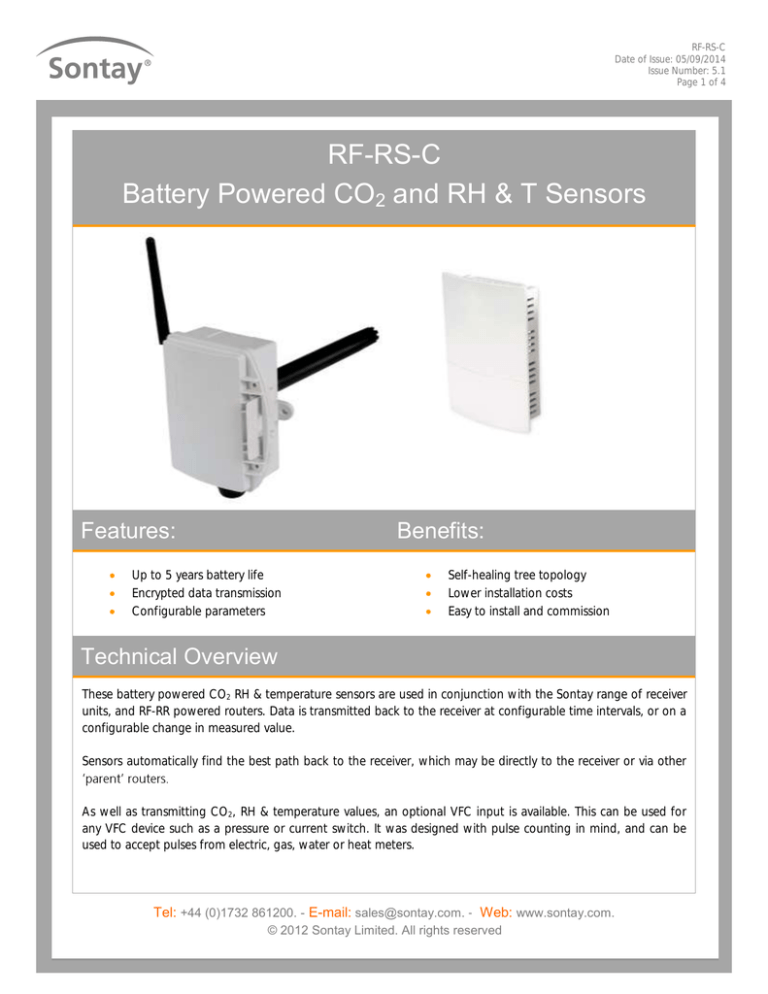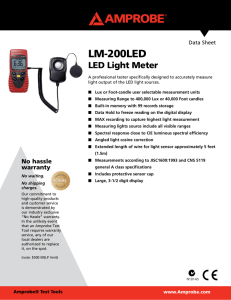
RF-RS-C
Date of Issue: 05/09/2014
Issue Number: 5.1
Page 1 of 4
RF-RS-C
Battery Powered CO2 and RH & T Sensors
Features:
Benefits:
Up to 5 years battery life
Encrypted data transmission
Configurable parameters
Self-healing tree topology
Lower installation costs
Easy to install and commission
Technical Overview
These battery powered CO2 RH & temperature sensors are used in conjunction with the Sontay range of receiver
units, and RF-RR powered routers. Data is transmitted back to the receiver at configurable time intervals, or on a
configurable change in measured value.
Sensors automatically find the best path back to the receiver, which may be directly to the receiver or via other
As well as transmitting CO2, RH & temperature values, an optional VFC input is available. This can be used for
any VFC device such as a pressure or current switch. It was designed with pulse counting in mind, and can be
used to accept pulses from electric, gas, water or heat meters.
Tel: +44 (0)1732 861200. - E-mail: sales@sontay.com. - Web: www.sontay.com.
© 2012 Sontay Limited. All rights reserved
RF-RS-C
Date of Issue: 05/09/2014
Issue Number: 5.1
Page 2 of 4
Specification:
Part Codes:
Common specification:
Radio Output:
Frequency
2.4GHz
16 channels, automatically selected
Direct-sequence spread spectrum
Compliance
IEEE 802.15.4-2006
Data Encryption
AES 128
Power Output
0dBm
Accuracy:
CO2
±75ppm
RH
±3% (20 to 80%RH)
Temperature
±0.3°C
Country of origin
UK
RF-RS-CO2-1000
Space CO2 sensor
Plant Housing:
Material
Dimensions
Battery (non-rechargeable):
Type
Life
Protection:
Snap-shut lid
RF-RS-CO2-RH-1000
Space CO2 RH & Temp sensor
Sensor option (add to part code)
-VFC
Volt free input
RF-RS-CO2-622
Duct CO2 sensor
ABS (flame retardant type VO)
116 x 106 x 52mm
RF-RS-CO2-RH-622
Duct CO2 RH & Temp sensor
3.6V 2/3 Li-SOCI2
>3 years (dependent on conf.)
IP54
IP65 (see page 4 note 7)
Ambient:
Temperature
RH
-30 to +70°C
0 to 90%, non-condensing
Probe:
Material
Dimensions
Aerial Characteristics:
Gain
VSWR
Space Housing:
Material
Colour
Dimensions
Ambient:
Temperature
RH
Protection
Aerial Characteristics:
Gain
VSWR
Probe, PVC
210 x 19mm dia.
2.0dBi
<2:1
ABS (flame retardant)
Polished white finish
115 x 85 x 28mm
-10 to 60°C
0 to 90%, non-condensing
IP30
1.2dBi
1.5:1
The products referred to in this data sheet meet the
requirements of EU Directive 2004/108/E
Tel: +44 (0)1732 861200. - E-mail: sales@sontay.com. - Web: www.sontay.com.
© 2012 Sontay Limited. All rights reserved
RF-RS-C
Date of Issue: 05/09/2014
Issue Number: 5.1
Page 3 of 4
How It Works:
Data is transmitted back to the receiver at configurable time intervals, or on a configurable change in measured value. Each
sensor retains these configurations if the battery becomes discharged or requires replacement.
The sensors, routers and receiver automatically select which of the 16 transmission channels available gives the best radio
network performance, taking into account both signal strength and interference levels from adjacent channels and
equipment (such as Wi-Fi etc.) The sensors automatically find the best path back to the receiver, which may be directly to the
receiver o
Aerial Orientation (plant sensor types);
For best results ensure that the main body of the aerial is vertical.
Plant Sensor types:
1.
Remove all packaging from the sensor. Note the MAC address printed on the affixed label and note where this
MAC address is installed.
2.
Mount the sensor in the required position (this will have been determined by the site survey tool, (see the quick
start guide and manual).
3.
Select a location in the duct where the sensor probe will give a representative sample of the prevailing air condition.
4.
Drill a 22mm diameter hole in the duct, then use the housing as a template mark the hole centres or use the
dimensions below), drill and fix the housing to the duct with the screws supplied.
46 mm
46 mm
Ø22mm
Tel: +44 (0)1732 861200. - E-mail: sales@sontay.com. - Web: www.sontay.com.
© 2012 Sontay Limited. All rights reserved
RF-RS-C
Date of Issue: 05/09/2014
Issue Number: 5.1
Page 4 of 4
Installation (continued):
5.
Release the snap-fit lid by gently squeezing the locking tab and install the Li-SOCI2 battery, observing the correct
polarity. To power on the unit, fit J600.
6.
Snap shut the lid after the connections have been made if IP65 protection is required, secure the lid with two
screws provided.
Ensure, at a minimum, that all routers and the receiver on the radio network are powered on, and allow about 5
minutes for the network to auto-commission before attempting to read values or make configuration changes.
7.
Space Sensor Types:
1.
Remove all packaging from the sensor. Note the MAC address printed on the affixed label and note where this
MAC address is installed.
2.
Mount the sensor in the required position (this will have been determined by the site survey tool, (see the quick
start guide and manual).
3.
Using the base as a template mark the hole centres and fix to the wall with suitable screws. Alternatively the base
plate can be mounted on to a conduit box or a standard recessed back box.
4.
Install the Li-SOCI2 battery, observing the correct polarity. To power on the unit, fit J600.
5.
Replace the housing to the base plate and re-fit the tamperproof screw through the lug at the bottom of the base
plate.
6.
Ensure, at a minimum, that all routers and the receiver on the radio network are powered on, and allow about 5
minutes for the network to auto-commission before attempting to read values or make configuration changes.
Battery Fitting & Replacement:
The current battery level of a sensor can be monitored using the CMS software connected to the receiver. When a battery is
first installed, or when it is replaced, observe the correct polarity. Fitting the battery incorrectly may result in
permanent damage to the sensor. Remove the power jumper prior to removing a battery. After fitting a battery, replace
the power jumper while pressing the reset button. This resets the hours run counter for the battery.
NB Lithium-Thionyl Chloride batteries are not rechargeable, and should be stored in a clean, cool (not exceeding +30°C),
dry and ventilated area.
Disposal of Batteries - Warning! Fire, Explosion and Burn Hazard.
Do not recharge, short-circuit, crush, disassemble heat above 100°C (212°F), incinerate, or expose the battery contents to
water. Do not solder directly to the cell.
All batteries must be disposed of in accordance with EC Directive 2006/66/EC, amended by EU Directive 2008/12/EC.
Tel: +44 (0)1732 861200. - E-mail: sales@sontay.com. - Web: www.sontay.com.
© 2012 Sontay Limited. All rights reserved
RF-RS-C
Date of Issue: 05/09/2014
Issue Number: 5.1
Page 5 of 4
Option:
VFC
Used for any VFC digital input (such as a pressure switch or current switch), but it has also been designed with pulse
transmitted immediately even
TRUE inputs is counted by the router or ED, and held in flash memory, so even if the ED or router doing the counting goes
offline for a while, it carries on counting
strategy to be updates when the ED or router comes back online meaning a pulse will never be missed. The ED or router can
hold the number of VFC TRUE conditions up to 4096, and is user resettable if required.
Whilst every effort has been made to ensure the accuracy of this specification, Sontay cannot accept responsibility for damage, injury,
loss or expense from errors or omissions. In the interest of technical improvement, this specification may be altered without notice.
Tel: +44 (0)1732 861200. - E-mail: sales@sontay.com. - Web: www.sontay.com.
© 2012 Sontay Limited. All rights reserved




